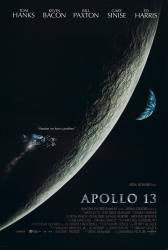
Trivia: The Captain of the Iwo-Jima who Tom Hanks talks to at the end of the movie is the real Apollo 13 astronaut Jim Lovell.
Trivia: The Apollo 13 mission set a record for the greatest distance from Earth ever achieved by mankind. This occurred because unlike the other Apollos, Apollo 13 did not make a burn behind the moon to drop into lunar orbit. The free-return trajectory the mission followed took the spacecraft farther behind the moon than any other mission.
Trivia: The exchange between Lovell and his wife about holidays ("you know that Easter vacation? There's been a change of destination ... how about the moon?") in fact took place in 1968, when Lovell was assigned to Apollo 8 and so missed his planned Christmas vacation.
Trivia: In an interview, Ron Howard revealed that, after a test screening, he was concerned about an audience reaction card that rated the film as "terrible" until he read a comment on the card dismissing the ending as "more Hollywood b*llsh*t", saying that had it happened in real life, the astronauts "would never have survived".
Trivia: When Bill Paxton vomits they used Beef-a-Roni stew for the vomit. Since they only had to use a spoonful for each take, they had half a can left at the end of the day. After losing a bet with Tom Hanks, Bill had to then eat the rest of the can. Bill Paxton confirmed this personally at an autograph signing.
Trivia: Marilyn Lovell did lose her wedding ring in the shower before hubby had his "problem." Check the audio commentary on the DVD. It wasn't added to the movie for dramatic effect. The ring, however, was recovered.
Trivia: Ron Howard's mother and father have cameos in the film. Ron's father, Rance Howard, plays the priest who keeps a vigil with the family, and his mother, Jean, plays Jim Lovell's mother.
Trivia: Thomas K. Mattingly (played by Gary Sinise), is bald (as opposed to Gary's full head of hair), and about 8 inches taller than the actor. Adm. Mattingly also speaks with a Texas accent.
Trivia: Many people have claimed that Lovell's LEVA (Lunar Extra-Vehicular Visor Assembly) is incorrect because it shows a Navy Anchor and "No LEVA had that." Interestingly enough, Jim Lovell's flown LEVA had a blue box containing the Navy Insignia, a custom made helmet and the only one of its kind in the entire program. NASA has a photo of it on their Apollo Lunar Surface Journal which can be viewed here: http://www.hq.nasa.gov/alsj/a13/a13LovellVisor.jpg.
Trivia: To make the effect of the actors in space they flew in NASA's KC-135 aircraft which simulated the weightlessness in space. All of the scenes where you can see the whole body of the actors are in the aircraft, and when it's only a part of the actor's body it's on ground.
Trivia: Ron Howard's wife appears as one of the nuns in the VIP crowd for the launch.
Trivia: Jack Swigert actually said "Houston, we've had a problem." It was changed in the film to "we have a problem" so the audience would know it was an ongoing problem and the crew were still in danger, also for Tom Hanks to deliver the line.
Trivia: During the broadcast, Fred starts playing the song "Spirit in the Sky," and Jim mentions it should have been the theme from "2001." In real life, the crew actually did play the theme from "2001." In this case, the film was joking about altering history for artistic purposes.
Trivia: Ron Howard's brother Clint is cast in this movie. He plays the flight controller White Team Electrical, Environmental and Consumables Manager (EECOM) Sy Liebergot.






Answer: Spacecraft re-enter Earth's atmosphere at extremely high velocity (thousands of miles per hour). Atmospheric friction slows the spacecraft descent somewhat; but, without parachutes, the Apollo spacecraft would still reach the surface traveling at hundreds of miles per hour. Landing in water at such high speed would be like hitting concrete, which would of course be instantly fatal. Hence the necessity of multiple parachutes. The Apollo program (and all early U.S. manned space programs) chose to land in the ocean for two reasons: 1) It was easier to track spacecraft re-entry from horizon-to-horizon at sea without visual and radar obstacles, and; 2) It was faster and easier to position several Navy vessels in the general splashdown location, then deploy helicopters to rapidly retrieve the astronauts and their spacecraft.
Charles Austin Miller